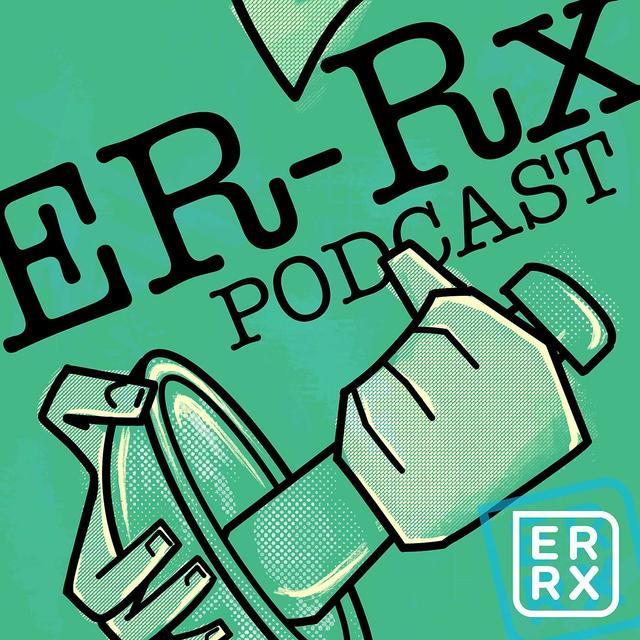Hello and welcome to Episode 28 of ER-Rx. In this week’s Fresh Fruit series, we discuss an interesting article published in the American Journal of Emergency Medicine entitled “ocular timolol as the causative agent for symptomatic bradycardia in an 89-year-old female.”
For some background, glaucoma refers to a group of eye diseases characterized by optic neuropathy. This neuropathy is often, but not always, accompanied by elevated intraocular pressure (IOP); as a result of either increased aqueous production, decreased aqueous outflow, or a combination of the two.
In open-angle glaucoma, treatment is centered around lowering IOP. Options include laser therapy, surgery, and/ or topical pharmacological therapy- which is often recommended first-line.
Topical agents work be either increasing aqueous outflow (using agents such as prostaglandins, alpha adrenergic agonists, and cholinergic agonists) or by decreasing aqueous production (by using agents such as beta-blockers, alpha adrenergic agonists once again, and carbonic-anhydrase inhibitors). Although prostaglandins (such as Xalatan or latanoprost) are usually chosen as first-line therapy, beta-blockers (such as timolol) are also a viable option, especially for patients who can’t afford prostaglandins. Beta-blockers were also mainstays of treatment before the prostaglandins came around.
Interestingly, these topical beta-blockers can be systemically absorbed, and they actually share the same contraindications as oral beta-blockers; such as avoiding their use in the setting of pulmonary and cardiac disease. These agents have been shown to worsen heart failure and to cause heart block, bradycardia, and syncope.
Easily forgotten and often overlooked, these topical beta-blockers have crazy pharmacokinetic profiles. For example, 0.5% timolol has the bioavailability, pharmacokinetic profile, and cardiac effects that are comparable to intravenous timolol! It also has a systemic bioavailability of 78%, which is higher than even oral timolol with its 61% bioavailability. As a matter of fact, one drop of 0.5% ophthalmic timolol is estimated to be equivalent to around 10 mg of oral timolol, which is a typical low starting dose for that agent in the setting of hypertension.
After installation into the eye, timolol is detected in plasma after 15 minutes and it has a half-life of around 4 hours with a duration of action of about 24 hours. Timolol is metabolized by the CYP2D6 enzyme which has a long list of inhibitors including common agents such as bupropion, fluoxetine, sertraline, and haloperidol.
Of course, in younger patients or those without any cardiac issues, they likely won’t experience these cardiovascular effects. Other patients, especially those that are older or those taking medications that are inhibitors of CYP2D6, may be slower metabolizers of timolol. This means that they are at risk of experiencing side effects, potentially even for a duration longer than 24 hours.
It’s important to note that there may be some latency to these cardiovascular side effects. Although sometimes noticeable within minutes or days of use, some patients only develop side effects after a number of years, including the case discussed in this particular report which developed after 4 years of use - making it even easier to miss when reviewing the med profile.
In conclusion, don’t forget about topical medications, and especially eye drops, when your patient in the ER, ICU, or hospital wards experiences bradycardia, syncope, or other cardiac events and you are trying to rule-out drug-related causes. Topical eye drops are especially easy to miss, as it’s just so counter-intuitive to assume that these eye drops are systemically absorbed, and to such a highly significant level.
As always, thank you so much for your time. Please check out our website: errxpodcast.com. There, you can subscribe to our newsletter, which when we get enough subscribers, we’ll start sending out key points from previous episodes and other tidbits.
Hopefully, with listeners on every continent (except Antarctica, for now…) my long-term goal is that we can use the newsletter as a place we can all share information, including ordersets, order-panels, and practices from different hospitals across the globe.

Episode 28- Blink and you miss it: an easily missed cause of bradycardia and hypotension
Episode description
Bradycardic? Hypotensive? Keep the agent discussed in this week's episode in mind when reviewing your patient's medication list.
References:
Rains J, Kesterson J. Ocular timolol as the causative agent for symptomatic bradycardia in an 89-year-old female. Am J Emerg Med. 2020; Article in Press
Wang Z, Denys I, Chen F, et al. Complete atrioventricular block due to timolol eye drops: a case report and literature review. BMC Pharmacology and Toxicology. 2019; 20: 73
Disclaimer:
The information contained within the ER-Rx podcast episodes, errxpodcast.com, and the @errxpodcast Instagram page is for informational/ educational purposes only, is not meant to replace professional medical judgement, and does not constitute a provider-patient relationship between you and the authors. Information contained herein may be accidentally inaccurate, incomplete, or outdated, and users are to use caution, seek medical advice from a licensed physician, and consult available resources prior to any medical decision making. The contributors of the ER-Rx podcast are not affiliated with, nor do they speak on behalf of, any medical institutions, educational facilities, or other healthcare programs.
Find ER-Rx:
- On Instagram: @ERRxPodcast
- On the website: errxpodcast.com
- On YouTube
Disclaimer:
The information contained within the ER-Rx podcast episodes, errxpodcast.com, and the @errxpodcast Instagram page is for informational/ educational purposes only, is not meant to replace professional medical judgement, and does not constitute a provider-patient relationship between you and the authors. Information contained herein may be accidentally inaccurate, incomplete, or outdated, and users are to use caution, seek medical advice from a licensed physician, and consult available resources prior to any medical decision making. The contributors of the ER-Rx podcast are not affiliated with, nor do they speak on behalf of, any medical institutions, educational facilities, or other healthcare programs.
